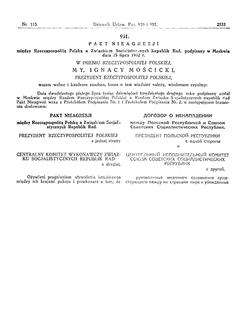Soviet–Polish Non-Aggression Pact

The Soviet–Polish Non-Aggression Pact (Polish: Polsko-radziecki pakt o nieagresji, Russian: Pakt o nenapadenii mezhdu SSSR i Pol’shey) was an international treaty of non-aggression signed in 1932 by representatives of Poland and the USSR. The pact was unilaterally broken by the Soviet Union on September 17, 1939, during the German and Soviet invasion of Poland.
Background
After the Polish–Soviet War, the Polish authorities pursued a policy of "equal distance" between Germany and the Soviet Union. Most of Polish politicians, both on the left and right, believed that Poland should rely mostly on the crucial alliance with France dating back to World War I and should not support either Germany or the Soviet Union.
To normalize the bilateral contacts with the Soviet Union, talks were started in January 1926 to prepare a non-aggression treaty. The treaty was to fortify the Polish gains of the Peace of Riga and was to be balanced by a similar pact signed with Germany. However, the talks with Germany were not started, and the Polish–Soviet talks were interrupted in June 1927, after Great Britain broke diplomatic relations with the USSR and Soviet plenipotentiary Pyotr Voykov was murdered in Warsaw. Instead, Poland applied to the Briand-Kellogg Pact of 1928. The Polish-Soviet negotiations were resumed in Moscow, in 1931. The pact was finally signed on July 25, 1932, effective for a three-year period. Ratifications were exchanged in Warsaw on December 23, 1932, and it went into effect on the same day. It was registered in League of Nations Treaty Series on January 9, 1933.[1] On May 5, 1934 it was extended to December 31, 1945 without amendment. Among other topics, both sides agreed to renounce violence in bilateral relations, to resolve their problems through negotiations and to forgo any armed conflict or alliances aimed at the other side.
On September 23, 1938, the Soviet Union sent a note to the Polish government informing it that the pact will be considered null and void in the case of Poland's participation in the occupation of Czechoslovakia . However, this threat was not carried out, as the Soviet government stated on October 31, after Poland occupied Zaolzie area, that the pact remained in force . and it was reaffirmed by the two powers on November 26, 1938 (see ). Finally the pact was broken by the Soviets on September 17, 1939, when the Red Army joined Nazi Germany's forces in their invasion of Poland, in accordance with the secret protocols of the Molotov–Ribbentrop Pact.
The pact was considered at the time as a major success of the Polish diplomacy, much weakened by the toll war with Germany, renouncement of parts of the Treaty of Versailles and loosened links with France. It also reinforced the Polish negotiating position with Germany, which resulted in signing of the German–Polish Non-Aggression Pact eighteen months later.
See also
- Soviet–Finnish Non-Aggression Pact
- Franco-Soviet Treaty of Mutual Assistance
- German–Polish Non-Aggression Pact
- Soviet–Japanese Neutrality Pact
- Budapest Memorandum on Security Assurances
References
- Oleg Nikolayevich Ken (2003). Moskva i pakt o nenapadenii s Pol’shey ('Moscow and the Non-Aggression Treaty with Poland'). Sankt Petersburg: PIAF of Russian Academy of Sciences. p. 129. ISBN 5-86763-136-2.
- Oleg Nikolayevich Ken (1996). Collective security or isolation? Soviet foreign policy and Poland, 1930–1935. St. Petersburg: Evropeyski Dom. p. 328. ISBN 5-85733-057-2.
- Jan Tomasz Gross (2003). Revolution from Abroad. Princeton: Princeton University Press. p. 396. ISBN 0-691-09603-1.
- Edmund Jan Osmanczyk (2002). Encyclopedia of the United Nations and International Agreements. Routledge (UK). p. 1817. ISBN 0-415-93923-2.
Notes
- ↑ League of Nations Treaty Series, vol. 136, pp. 42-53.